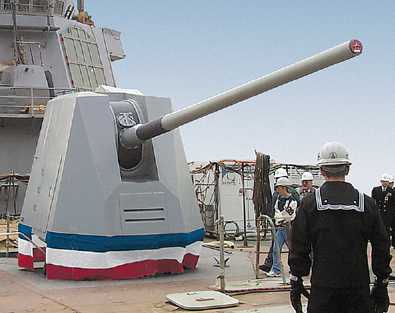This latest version of the Mark 45 gun mount was designed to be used with the Extended Range Guided Munition (Mark 171 ERGM) in order to provide over-the-horizon range and improved lethality. Modifications for structural improvements include strengthened trunnion supports and a lengthened recoil stroke to accommodate the higher firing energy (18 vs. 10 megajoules) associated with ERGM. Additionally, the gun mount modifications include a new 62-caliber barrel, an Ammunition Recognition System, a Gun/ERGM interface and a new control system.
The Ammunition Recognition System identifies ERGM projectiles and propelling charges and preclude the unsafe mixing of ERGM and conventional ammunition. A Gun/ERGM interface will provide for the transmission of pre-flight data into the guidance and navigation subsystems of the ERGM prior to loading and firing. The control system is modified to accommodate ERGM changes and to digitally interface with the Mark 160 Mod 8 Gun Computer System. With an ORDALT, existing WM25 Fire Control Systems for the 5"/54 (12.7 cm) Mark 45 may also be used.
A 23 August 2007 BAE press release stated that BAE had been awarded a contract for the overhaul, manufacture and upgrade of these guns and mountings as part of the CG-47 Cruiser Modernization program. It had been planned that ships would replace their existing 5"/54 (127 mm) guns and mountings with the Mark 45 Mod 4 but this was cancelled. A later program to modernize the Ticonderoga Flight II cruisers included replacing the older weapons with the Mod 4. See Gun Notes below for details.
In regards to the ERGM and BTERM munitions, a 15 March 2005 House Armed Services Committee Subcommittee on Projection Forces report stated "In order to mitigate risk for the munitions development, the Navy will conduct an open source selection in Fiscal Year 2005 between the Extended Range Guided Munition (ERGM), the Ballistic Trajectory Extended Range Munition (BTERM) and potential competitors. The contract will be awarded in early Fiscal Year 2006 with IOC planned for Fiscal Year 2011." Other information on these guided munitions may be found below in the Ammunition section.
However, in March 2008 the Navy abandoned the ERGM, after it failed a series of tests in February 2008. This ended a 12-year, $600 million project that has been plagued with multiple problems. BTERM also failed a series of tests around this same time and was likewise cancelled.
With the failures of the ERGM, BTERM and now LRLAP, the Navy in 2014 issued a Request for Information (RFI) about converting existing industry-available guided munitions such as the US Army's Excalibur and OTO-Melara's Vulcano for 5" (127 mm) and 155 mm guns, but little has come of this effort.
However, a promising program was the Hypervelocity Projectile (HVP) which was originally developed for the Electromagnetic Railgun program. This program was also cancelled in 2021. See below for details.
The Republic of Korea has purchased a manufacturing license for these guns in which United Defense delivers most of the upper gun, the shield and the loader, while the Republic of Korea company World Industries Ace (WIA) is responsible for the production of the lower hoist, the panels and the assembly and test of the gun itself. A 19 December 2002 press release by United Defense stated that the Republic of Korea had purchased total of six weapons.
Japan has also purchased a manufacturing license for these weapons for use on their Atago class Aegis destroyers. Japan Steel Works will manufacture, assemble and test the weapons. The Republic of Korea has selected this weapon to arm their newest destroyers. Denmark has purchased two of these weapons, the first European country to use this weapon.
United Defense made a proposal in mid-2004 that the British Type 45 destroyers use this weapon, but the proposal was turned down and the Type 45 are being armed with the 114 mm (4.5") Mark 8 Mod 1 mountings.
In July 2016 BAE Systems announced that they had received a $245 million contract from the UK Ministry of Defence (MOD) to provide the gun system, known as the Maritime Indirect Fires System (MIFS), for the Type 26 Global Combat Ship. Under the contract, BAE will manufacture three MIFS Integrated Gunnery Systems (IGS) and one trainer system for the UK Royal Navy. The MIFS IGS includes the 5-inch, 62-caliber Mk 45 Mod 4 Naval Gun System, along with an automated ammunition handling system, gun fire control system, and qualified ammunition. The contract includes an option for five additional systems for the remainder of the UK Royal Navy’s Type 26 fleet. This same press release also stated that more than 240 Mark 45 guns had been delivered globally. The release does not state if this count includes the older 5"/54 (127 mm) Mark 45 but I believe that it does.
| Designation | Gun: 5"/62 (12.7 cm) Mark 36
Mounting: 5"/62 (12.7 cm) Mark 45 Mod 4 |
|---|---|
| Ship Class Used On | United States 1
New-construction Arleigh Burke class DDG's - First installed on USS Winston Churchill DDG-81 Ticonderoga Flight II Modernizations - First installed on USS Cowpens CG-63 Republic of Korea
Japan
Denmark
Britain
|
| Date Of Design | 1995 |
| Date In Service | 2000 |
| Gun Weight | N/A |
| Gun Length oa | N/A |
| Barrel and Bore Length | 310.0 in (7.874 m) |
| Rifling Length | N/A |
| Grooves | N/A |
| Lands | N/A |
| Twist | N/A |
| Chamber Volume | N/A |
| Rate Of Fire 2 | 16 - 20 rounds per minute |
- ^As many as 14 Ticonderoga (CG-47) class cruisers were planned to be upgraded to the 5"/62 (12.7 cm) depending upon available funding. Upgrades were to include using the Mark 160 Mod 11 Gunfire Control System (GCS) and two Mark 46 Mod 1 optical sight systems to replace the Mark 86 GCS. Magazine stowage flexibility was to be enhanced with the installation of the universal tie down system in both forward and aft magazines. However, it was not planned to make these ships capable of handling larger rounds such as ERGM or BTERM. In January and February 2004, the Navy decided to save money by not upgrading these ships to the larger guns and $100M was cut from the Cruiser Modernization program. In May 2004, the US Congress sent a letter to the Secretary of the Navy asking the USN to reconsider this decision. In August 2007, BAE announced the awarding of a Basic Ordering Agreement (BOA) from the U.S. Navy which included upgrading the CG-47 Flight II cruisers to the 5"/62 (127 mm) Mod 4. However, the SLEP (Ship Life Extension Program) for these cruisers as originally funded did not include replacing the existing 5"/54 gun mounts, but funding for this changeout was later added. Other items to be updated include the Hull, Mechanical and Electrical (HM&E) systems. Sensor sets will also be improved, in order to upgrade their anti-submarine capabilities, add short range electro-optical systems that can monitor the ship's surroundings without the use of radar emissions, as well as routine machinery upgrades to improve all areas of ship functionality. Two cruisers per year are to enter the program starting with USS Cowpens (CG-63) and USS Gettysburg (CG-64) which began modernization in fiscal year 2015.
- ^The Rate of Fire in this table is for conventional ammunition. The planned rate of fire for ERGM or ANSR rounds was to be a maximum rate of approximately 10 rounds in the first minute. The sustained rate was to be 2 to 4 rounds per minute and depended upon the magazine crew's ability to manually move rounds from the shipping container to the loading position.
| Type | Separate |
|---|---|
| Projectile Types and Weights 1a 2a 3a | Mark 80 HE-PD - 67.6 lbs. (30.7 kg)
Mark 91 Illum-MT - 63.9 lbs. (29.0 kg) Mark 116 HE-VT - 69.7 lbs. (31.6 kg) Mark 127 HE-CVT - 68.6 lbs. (31.1 kg) Mark 156 HE-IR - 69.0 lbs. (31.3 kg) Mark 172 HE-ICM (Cargo Round) - N/A ERGM - 110 lbs. (50 kg)
HVP (Integrated Launch Package) - 40 lbs. (18 kg)
|
| Bursting Charge | See Note 4a |
| Projectile Length | Mark 80 - 26 in (66 cm)
Mark 91 - 26.1 in (66.3 cm) Mark 116 - 26 in (66 cm) Mark 127 - 26 in (66 cm) Mark 156 - 26 in (66 cm) Mark 172 - 26 in (66 cm) ERGM - 61 in (155 cm) BTERM - 61 in (155 cm) HVP (Integrated Launch Package) - 26 in (66 cm) HVP (Flight Body) - 24 in (61 cm) |
| Propellant Charge 5a 6a | Mark 67 - 18.25 lbs. (8.3 kg) NACO
Cartridge weighs 38.9 lbs. (17.6 kg) filled EX-167 for ERGM - about 25 lbs. (11.3 kg) EX-99
EX-175 High Energy - about 26 lbs (11.8 kg)
|
| Muzzle Velocity | Mark 80 projectile with Mark 67 cartridge - 2,725 fps (831 mps)
Mark 80 projectile with EX-175 cartridge - 3,450 fps (1,052 mps) Mark 91 projectile with Mark 67 - 2,750 fps (838 mps) ERGM with EX-167 cartridge - 2,750 fps (838 mps) HVP - Quoted as "Mach 3" |
| Working Pressure | Mark 67 cartridge - 18.5 tons/in2 (2,758 kg/cm2)
EX-167 cartridge - 29.0 tons/in2 (4,570 kg/cm2) EX-175 cartridge - N/A |
| Approximate Barrel Life with Mark 67 cartridge 7a | 7,000 rounds |
| Ammunition stowage per gun | Arleigh Burke: 680 rounds 8a 9a 10a |
- ^This weapon has many different kinds of ammunition. The ones listed above are meant to be representational, but by no means is this a complete listing.
- ^Ammunition abbreviations:
HE-PD = High Explosive, Point Detonating Fuze
Illum-MT = Illumination, Mechanical Time Fuze
HE-VT = High Explosive, Variable Time Fuze
HE-CVT = High Explosive, Controlled Variable Time Fuze - ^All projectiles have a 0.5 caliber boat-tail.
- ^Most conventional rounds have a burster of about 7.75 lbs. (3.52 kg). The ERGM has a burster of 7.2 lbs. (3.3 kg) PBXN-9 explosive. BTERM has a fragmenting warhead made up of 9.9 lbs. (4.5 kg) preformed tungsten fragments plus 7.6 lbs. (3.4 kg) of explosives. The Mark 172 cargo round holds 49 Mark 2 submunitions. The HVP has a payload capability of 15 lbs. (6.8 kg) which includes any needed electronics and packaging.
- ^The Mark 67 cartridge uses standard NACO propellant. The EX-167 extended-range guided munitions (ERGM) propelling charge uses EX-99 propellant.
- ^The rocket engine on ERGM burns for 7 seconds. The rocket engine on BTERM provides 20 seconds of burn time.
- ^The introduction of higher energy, hotter burning propellant for ERGM would have reduced the expected gun barrel life. The threshold wear life of the Mark 45 Mod 4 gun barrel for ERGM was estimated at 1,500 rounds with an objective of 3,000 rounds. This is compared with the current 5"/54 (12.7 cm) Mark 45 barrel wear life in excess of 8,000 rounds for ballistic ammunition fired with standard NACO propellants. Extended range ammunition such as BTERM that use a "boost to range" concept can be fired using cooler burning propellants such as NACO and therefore will not adversely affect barrel life.
- ^The Arleigh Burke class ammunition magazine takes approximately 16 hours to be loaded out with 680 ballistic projectiles and associated propelling charges during at-sea replenishments. This assumes favorable weather conditions and calm seas.
- ^The addition of extended range guided munitions such as ERGM or BTERM would have required a manual magazine reconfiguration to accommodate the specific mix of ammunition provided. These guided munitions would also have required additional load cycles because only 16 of these guided rounds could fit on a standard pallet versus 48 conventional ballistic rounds.
- ^The ammunition stowage figure above for the Burke DDG is for conventional projectiles. Each ERGM projectile takes the place of about 1.75 conventional projectiles. It was estimated in 1998 that an Arleigh Burke DDG could carry 680 conventional projectiles or about 230 conventional projectiles and 230 ERGMs. The ready-service loader drum for this mounting has a maximum capacity of 20 ballistic rounds or 10 extended-range rounds (such as ERGM or BTERM). Ballistic and extended-range rounds can be mixed in the drum.
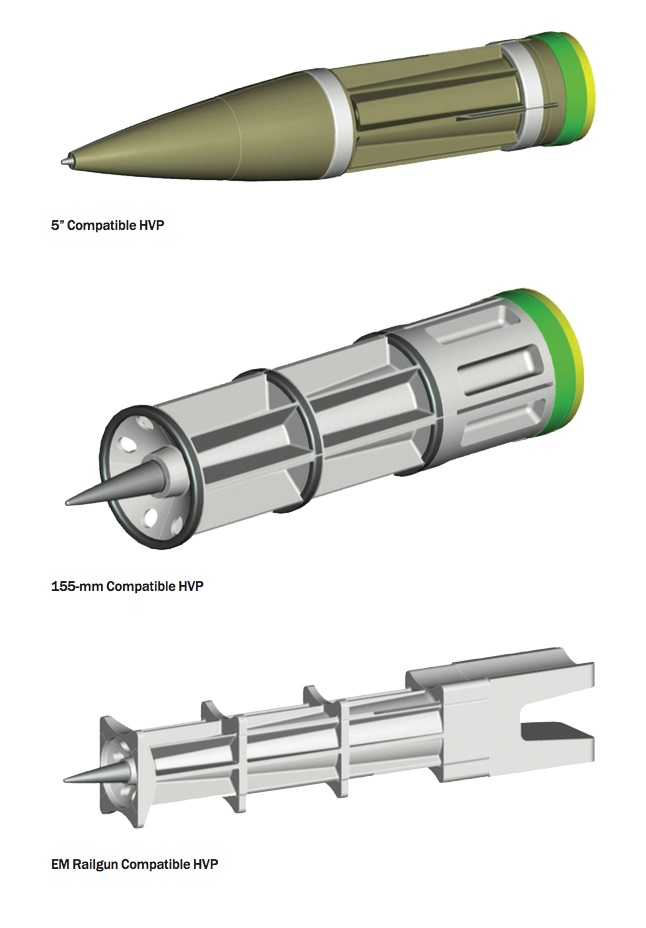
The Hypervelocity Projectile (HVP), later renamed Gun-Launched Guided Projectile (GLGP), was originally developed as part of the Electromagnetic Railgun program. The railgun program has fallen out of favor with the Defense Department, with funding being greatly reduced in recent years which has has slowed or halted development work. However, the HVP captured the imagination of the Pentagon as it could be adapted for use with existing weapons such as the naval 5"/54 and 5"/62 (12.7 cm) Mark 45 guns and the Army/Marine 155 mm guns, albeit with much reduced muzzle velocity and range. As the HVP in the 5" (12.7 cm) Integrated Launch Package is the same size as a conventional 5" (12.7 cm) naval projectile, it can replace conventional projectiles on a one-to-one basis and it is compatible with all handling and magazine equipment in the Mark 45 mountings. However, HVP was cancelled in June 2021 as Congress found "that fielding to ships would involve integrating the round with existing combat systems, and additional tests and war-gaming." Congress and the Navy concluded that the costs for these items outweighed the potential benefits. However, in December 2024, the US Army awarded a sole-source contract to BAE Systems to produce Hypervelocity Projectiles and integrate them into eight different weapon systems including those for the US Navy. The program has a requirement to develop and deliver a "multi-domain artillery cannon" (MDAC) weapon system battery by the fourth quarter of fiscal 2027 and carry out an operational demonstration in fiscal 2028.
Prior to 2015, the Defense Department thought that the Railgun would be a major focus of development, but as alternatives were investigated, it was realized that a standard naval gun with a hypervelocity round could have almost the same impact as a railgun but at a fraction of the developmental costs. This was because this approach did not require the development, testing and adaptation of a new weapon system like the railgun. With the development of guided versions, the HVP is now seen as being capable of intercepting sub-sonic cruise missiles and large UAV drones, which gives the military a new, lower cost weapon system that can be used against these threats rather than the more expensive missiles such as the ESSM or RAM that are currently used.
As the US Army, Marines and Navy have between them over 1,000 conventional guns that can fire the HVP, this change in vision has led to a major project reorientation of the HVP towards the air defense role with significant increases in production quantities and thus a resulting lower cost per round for the HVP. It is now (2020) estimated that the cost of the guided HVP will be about $86,000 per round vs. $2 million per ESSM and $1 million per RAM.
As part of the RIMPAC 2018 exercises, the Burke-class guided missile destroyer USS Dewey (DDG-105) successfully fired 20 HVP rounds from her 5"/62 (12.7 cm) gun in an experiment to demonstrate the compatibility of guns and projectiles.
On 8 September 2020, an Army 155 mm Paladin Howitzer using an HVP shot down a bomber-launched BQM-167 Skeeter aerial target, which imitates a cruise missile. According to an article web published in Air Force Magazine on 4 September 2020: "The main live-fire scenario took place at White Sands, where bombers launched six BQM-167 targeting drones to simulate a cruise missile threat. Multiple systems targeted the BQM-167s, including the HVP round from the Paladin and a U.S. Navy deck gun, along with an AIM-9X Sidewinder missile fired from an F-16, an MQ-9, and a ground launcher. The outcome of the other launches is not public, Roper [Will Roper, the Air Force’s assistant secretary for acquisition] said, but the HVP’s success is and was a success story for a relatively unknown capability started at the Strategic Capabilities Office in 2013."
It should be clearly understood that the HVP was not intended as a replacement for the cancelled ERGM and ANSR/BTERM munitions described below. Those were essentially gun-launched, land-attack missiles whereas the HVP is a ballistic round intended for air defense and close range surface targets.
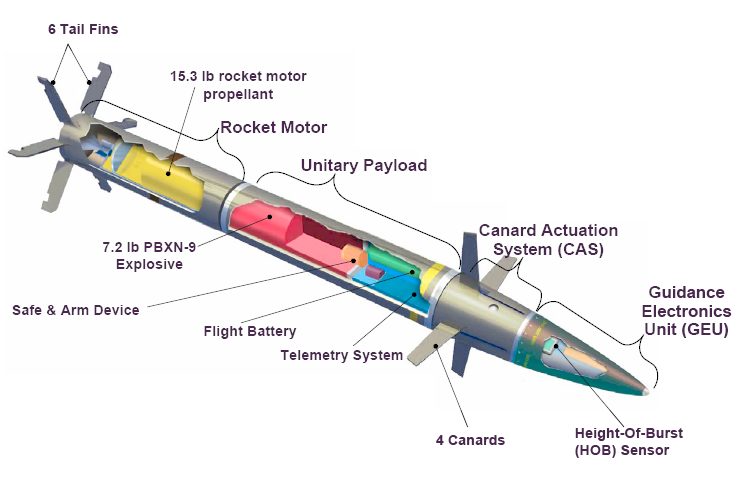
This section provides some details of the development history of ERGM along with some test results. The ERGM program had a troubled development and was ultimately cancelled.
The ERGM is a 12-caliber, rocket-assisted projectile. The projectile is launched from the 5" (12.7 cm) gun mount and guided to its target using both a Global Positioning System (GPS) and an inertial guidance system for a planned CEP accuracy of 10 to 20 meters. The warhead was originally to contain 72 submunitions, but this was later changed to be a unitary blast fragment type. As ERGM is much heavier than conventional munitions and has much longer range specifications, a special propellant charge is required. The resulting substantially increased firing "blow" led to the need for a more robust mounting with a longer gun barrel and hence the development of the 5"/62 (12.7 cm) Mark 45 Mod 4.
From a 15 June 2005 audit report issued by the Department of Defense Office of the Inspector General: "In September 1996, the Navy awarded Texas Instruments, Lewisville, Texas, a cost-plus-award-fee development contract for $43. 9 million to design and develop the ERGM. The Navy Acquisition Plan stated that development costs for the ERGM Program would be $113. 2 million and that technical development risk was low to medium. The Project Manager, Naval Surface Fire Support (the Project Manager) based the report's cost projections on the assumption that the technology from the former semi-active Laser Guided Projectiles developed in the 1980s could be leveraged without significant redesign. In January 1997, Raytheon Missile System (Raytheon), Tucson, Arizona, acquired Texas Instruments and relocated work on the ERGM development contract to Tucson. Since the relocation, the Navy has twice restructured the contract, with contract development costs increasing from $43.9 million to $178.6 million and estimated ERGM total life-cycle costs increasing from $523.7 million to $1.37 billion. In June 2004, the Project Manager notified the Navy Acquisition Executive that the ERGM Program was close to the threshold for classification as an acquisition category I program because the projected research, development, test, and evaluation (RDT&E) funding totaled $363 million."
The 25 October 1999 issue of Inside the Navy reported that Dr. Lee Buchanan, Assistant Secretary of the Navy for Research, Development and Acquisition, in an 8 October letter to Raytheon's chief executive officer, expressed "great concern" about the ERGM development and stated that "we have no confidence that the end [of ERGM's problems] is in sight. I have insisted that [Navy program officials] seriously consider even the most extreme alternatives as I do not believe that marginal adjustments will be effective." He added that, "The [R&D] cost of the program has more than doubled and current predictions call for delivery at least three years late." The article went on to say that the problems with ERGM are "frustrating senior service officials who are concerned that, despite conquering some challenges, further development puzzles still lie ahead." Some of the problems reported include unacceptably short barrel life and failure of the ERGM guidance system. In the FY2001 fiscal plan, the Navy greatly increased the development budget for this weapon in an effort to speed deployment.
According to a 26 June 2002 Raytheon Press Release, a test flight on 25 June 2002 for the "ERGM was launched from a representative Mk45 Mod 4 gun system, using a tactical propellant charge, and successfully executed navigation and guidance after global positioning system (GPS) acquisition. This flight test achieved all test objectives. The projectile demonstrated proper navigation and guidance despite experiencing extreme G-forces during gun launch . . . The test also demonstrated a flight range of 39 nautical miles in under four minutes time of flight and airframe stability and control with proper internal system operation." This last sentence apparently reflects an increase in actual flight time from what was expected previously. According to a Naval Surface Warfare Center (NSWC) document from 1997, "Concept of Employment for Naval Surface Fire Support (Near-term Capability)," the time of flight for 40 nm was then expected to be 2.5 minutes and that for 63 nm to be 7.5 minutes. See ERGM Time of Flight below for more detail.
Three ERGM unitary warhead tests have taken place as of March 2003. These have all successfully met the design goals of the project.
An April 2003 briefing paper by Admiral Vern Clark to the Seapower Subcommittee of the Senate Armed Services Committee stated that ANSR and ERGM would be "headed for a "shoot off" in FY05 to determine which round will provide greater range, lethality, and accuracy and ultimately be incorporated into the Navy's arsenal. "
The ERGM program has experienced multiple cost and schedule overruns and is now in danger of being suspended. A March 2004 GAO report stated: "The ERGM program began development with very few of its critical technologies mature, and while progress has been made, program officials do not expect to achieve maturity on all critical technologies until at least February 2004. No production representative engineering drawings were released to manufacturing by the design review; however, over half of these drawings have since been released. The program office expects to have a complete and updated drawing package by October 2004. Finally, due to several test failures, the program did not meet a Navy deadline that required successful completion of two land-based flight tests by November 2003. The Navy is conducting an independent assessment of the program's readiness to proceed with further flight-testing. The Navy has also issued a solicitation for alternative precision-guided munition concepts that could offer cost savings." In May of 2004, the planned introduction date for ERGM was moved to 2006 vs. the originally scheduled date of 2002 and it was estimated that each ERGM round would cost $50,000 US. A November 2004 GAO report estimated service introduction of ERGM could be delayed to as late as 2011 and noted that the Navy was now proposing diverting the monies appropriated for it to fund railgun development.
During a test shoot in April 2004, the ERGM did not deploy its tailfins and the rocket motor failed. However, in a February 2005 test, two ERGM rounds were launched from a representative Mark 45 Mod 4 gun system, using a tactical propellant charge, and successfully executed navigation and guidance after global positioning system (GPS) acquisition. Quoting from the 17 February 2005 Raytheon press release: "Both rounds exited the gun after transferring through a severe gun environment; additionally the tails erected and the rocket motor ignited. Moreover, both rounds achieved stable flight, acquired and tracked GPS satellites, developed in-flight navigational solutions, and guided to the target area more than 40 nautical miles away. The first round flew into the target arena and detonated the warhead." This wording seems to suggest that the second round did not enter the target arena.
ERGM Time of Flight from "Naval Surface
Fire Support Overview" by Major Jeff Graham, USMC
15 nautical miles (nm) = 1.5 minutes
30 nm = 3.0 minutes
50 nm = 5.5 minutes
ERGM rounds are to be stored as "wooden" rounds, that is, they are powered down to a safe mode. After the round is placed into the loader drum, target and GPS data is inductively transmitted to the ERGM via a special Setter Hood that fits over the nose of the projectile. It takes an average of 2.6 seconds for all target and GPS data to be transferred to the ERGM.
In February 2008, the Navy and Ratheyon conducted a series of test firings, which were reportedly unsuccessful. As a result, the Navy canceled further funding in March 2008 and the project is now considered to be finished.
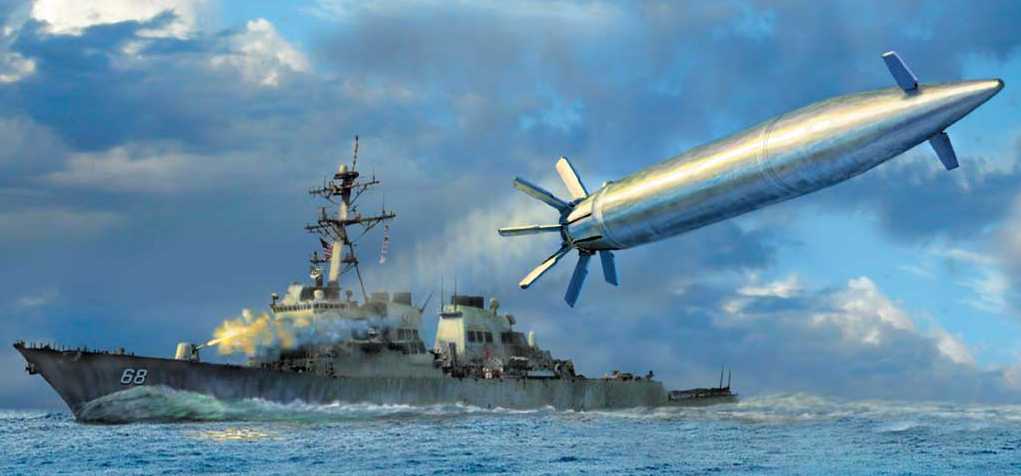
This section provides some details of the development history of ANSR and BTERM along with some test results. The ANSR/BTERM program, like the ERGM program, has been cancelled.
This is another long-range, rocket-assisted guided projectile that was developed by Alliant Techsystems (ATK). This was originally known as the Autonomous Naval Support Round (ANSR) but was later known as the Ballistic Trajectory Extended Range Munition (BTERM). ANSR was something of a private venture by ATK, receiving little official development monies from the Navy. The round was much simpler in concept than the ERGM and basically traded warhead weight for sustainer propellant.
ANSR was described in an article by Daniel Goure in the February 2003 issue of Navy League of the United States as follows:
Range is not ANSR's only distinguishing feature, though. Unlike most competitors, ANSR flies a purely ballistic trajectory that helps to simplify system design and reduces its susceptibility to countermeasures. And it uses a global positioning system and other high-tech systems to provide exceptional accuracy. ANSR is compatible with both 5-inch/54 and 5-inch/62 caliber naval guns. This means it can be deployed both on existing Navy ships -- providing an immediate fire-support capability of some 150 guns -- and on the new DD(X).Precision munitions tend to be quite costly. The ANSR may have solved that problem. Its warhead -- a derivative of that in the HARM anti-radar missile -- weighs approximately 25 pounds, including ten pounds of explosive, and is fitted in a tungsten case that will fragment on detonation. The fragmenting warhead, coupled to a precision-guidance system, provides four times the lethality of a steel-cased warhead of equivalent size. ANSR thus would be a low-cost solution, permitting volume as well as precision fires.
The following is taken from an ATK press release of 03 October 2003: "On Sept. 24, at the White Sands Missile Range (WMSR) in New Mexico, two Autonomous Naval Support Rounds (ANSR) flew more than 61 miles (54 nautical miles) in less than three minutes. Using inputs from up to nine GPS satellites, the projectiles guided to within 20 meters of their designated targets."
ATK announced in a press release dated 11 May 2004 that their "Ballistic Trajectory Extended Range Munition (BTERM) II, an extension of the earlier Autonomous Naval Support Round (ANSR), captured the highly competitive award for development of the Navy five-inch Extended Range Munition (ERM). With a value of $30 million, the contract calls for ATK to perform a 16-month demonstration of an innovative extended range, low cost, gun launched projectile capable of operation in the Mk 45 Mod 4 and Mod 2 naval gun systems."
BTERM uses a single axis control system (autopilot) that consists of a single-pair of canards for lateral control and tail fins for stability. The canards are deployed just prior to guidance activation which typically occurs at apogee; the fins are deployed right after the projectile leaves the muzzle. The projectile rolls about its longitudinal axis throughout its flight at a rate of 20-30 RPM and the control system uses roll commutation to translate guidance commands into canard deflection commands.
According to a Defense Daily report, ATK conducted an engineering test of a redesigned rocket motor with an unguided round at White Sands on 31 October 2005. The redesigned rocket suffered an early motor burnout, leading to a cancellation of a test planned for 4 November 2005.
ATK announced in a 22 February 2006 Press Release that the BTERM development team had "successfully conducted a challenging short-range, unboosted, guided flight test of ATK's ballistic trajectory extended range munition (BTERM) in support of the Navy's extended range munition (ERM) requirement. In this engineering test, the advanced, BTERM guided projectile flew more than 8 miles and landed within two meters of the target. This is the latest in a series of engineering tests leading up to guided and boosted flight-tests, currently being scheduled for this spring. "
ATK announced in a 25 April 2006 Press Release that it had successfully fired a BTERM rocket motor in an boosted, unguided test. In this test, the unguided round exited the gun barrel, achieved ignition and then performed a complete burn, thus validating the rocket motor design. In a separate flight test, the Ignition Safety Device (ISD) successfully ignited the rocket motor four seconds after exiting the gun barrel. The ISD is critical to the round's range performance across the entire set of range requirements, which extends from 15 nautical miles to 55 nautical miles. Both tests were conducted on 14 April 2006 at the Yuma Proving Grounds in Arizona.
BTERM failed some of the crucial elements of later tests and the Navy has cancelled any further effort in this direction. In a March 2007 Government Accountability Office (GAO) report a US Navy official stated that the US Navy concluded that Extended Range Munition (ERM) was a more viable option for fielding a tactical round by FY11, and it was no longer requesting funding for BTERM. Navy officials stated at that time that a competition could still occur in 2011 for ERM production. However, a 2011 GAO report says that the Navy has now dropped the ERM program.
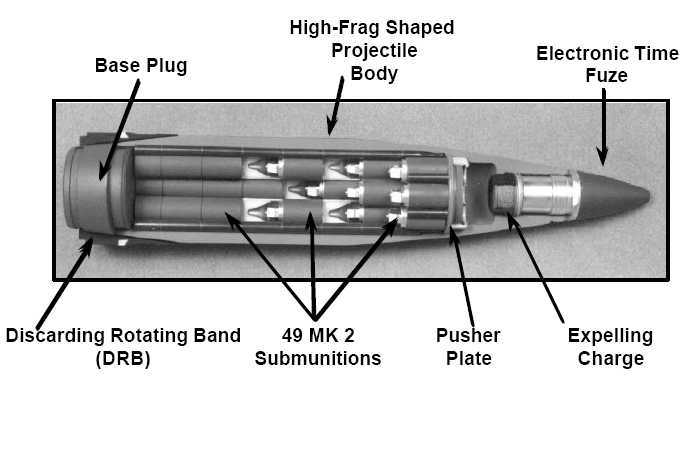
This round carries 49 Mark 2 submunitions, which are a variation of the Army's M-80 DPICM. This round is designed to explode above the ground in order to dispense its munitions over a wide area. As this is an unguided round, its CEP is considerably larger than those of the ANSR and ERGM projectiles, about 365 yards (333 m) at 16 nm (29 km).
This round may also be used against surface targets, especially high-speed attack boats, where its wide dispersal pattern is considered to be very useful.
| Elevation | With Conventional Projectiles using Mark 67 Cartridge |
With Conventional Projectiles using EX-175 Cartridge |
With Mark 171 ERGM | With ANSR | With HVP |
|---|---|---|---|---|---|
| Range @ 47 degrees | 25,880 yards (23,660 m) | about 40,000 to 42,000 yards (36,600 to 38,400 m) | Up to 63 nm (115,000 m) | Up to 55 nm (98 km) | Greater than 50 nm (89 km) w/5"/62 (12.7 cm)
Greater than 40 nm (71 km) w/5"/54 (12.7 cm) |
- Illumination rounds are automatically timed to ignite at an altitude of 1,050 feet (320 m) over the target area.
- ERGM was intended to be used against targets 13 to 63 nautical miles (nm) away from the firing ship. Conventional munitions would be used against closer targets. According to "Concept of Employment for Naval Surface Fire Support (Near-term Capability)" a Naval Surface Warfare Center document from 1997, at ranges up to 40 nm, the ERGM flies a ballistic flight path and has a time of flight of about 2.5 minutes. At longer ranges, the flight path was not ballistic and the time of flight increased significantly, up to a duration of 7 minutes at the maximum range of 63 nm. However, a 26 June 2002 Raytheon Press release suggests that the time of flight for 40 nm was closer to four minutes.
- During a test firing in 2003, a ANSR round flew 54 nm (96 km) in less than three minutes.
| Designation | Single Mounting: Mark 45 Mod 4
USA
Denmark
Japan
Republic of Korea
Britain
|
|---|---|
| Weight | Mounting without lower hoist: 50,456 lbs. (22,886 kg) [est.]
Mounting with four-flight lower hoist: 54,398 lbs. (24,674 kg) [est.] |
| Elevation | -15 / +65 degrees |
| Elevation Rate | 20 degrees per second |
| Train | +170 / -170 degrees |
| Train Rate | 30 degrees per second |
| Gun recoil 1c | 19 to 21 in (48 to 53 cm) |
- ^The recoil distances given above are nominal values when firing a conventional projectile with a standard service charge at elevations between 30 and 40 degrees. When fired with a proof charge at max elevation, recoil is about 23 inches (58 cm). If the heavier BTERM or ERGM projectiles are fired at max elevation and at proof pressure, then the gun will recoil about 29.25 inches (74 cm). The absolute, metal-to-metal recoil distance is 30 inches (76.2 cm).
- In general, the design of the Mark 45 Mod 4 mounting is similar to the original Mark 45 mounting and they share many of the same components.
- The Mark 45 Mod 4 mounting has a reduced radar signature as compared to the original Mark 45 mounting.
- This mounting requires 440 VAC, 60 Hz, 164.35 KW Peak.
- Manning is Gun Captain, Panel Operator and four ammunition operators, all below deck.
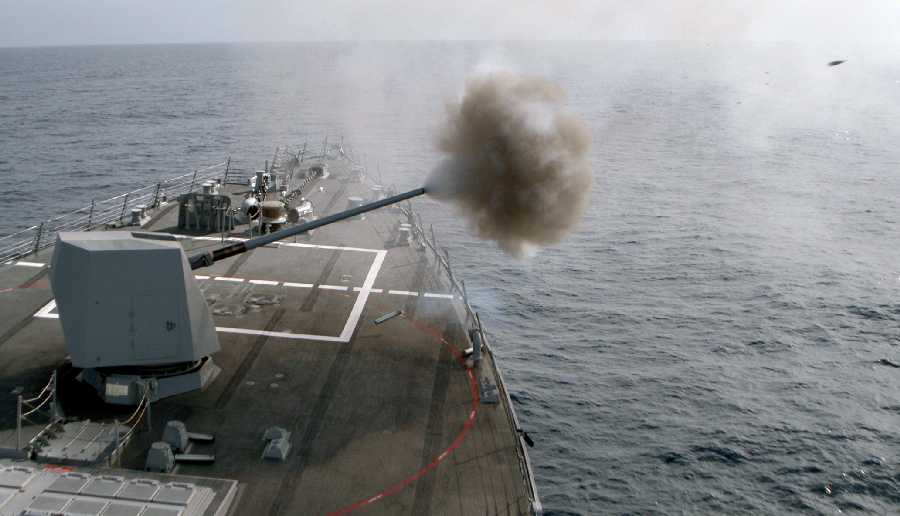
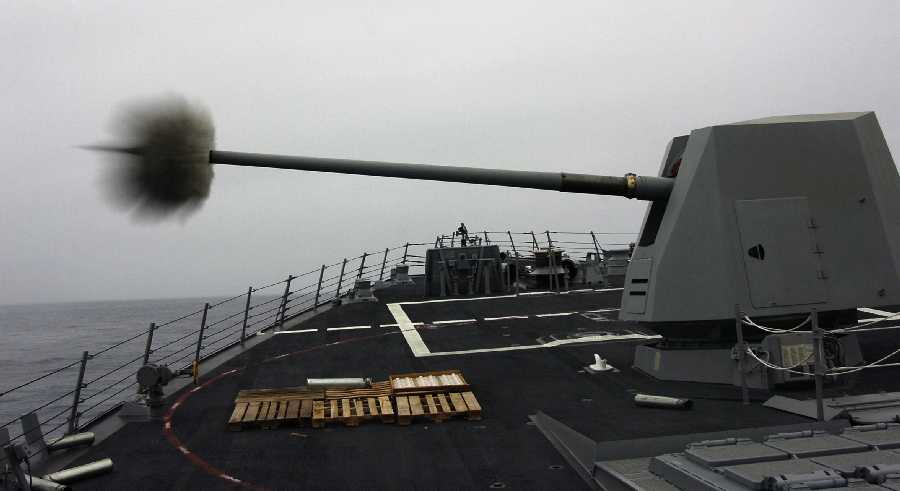
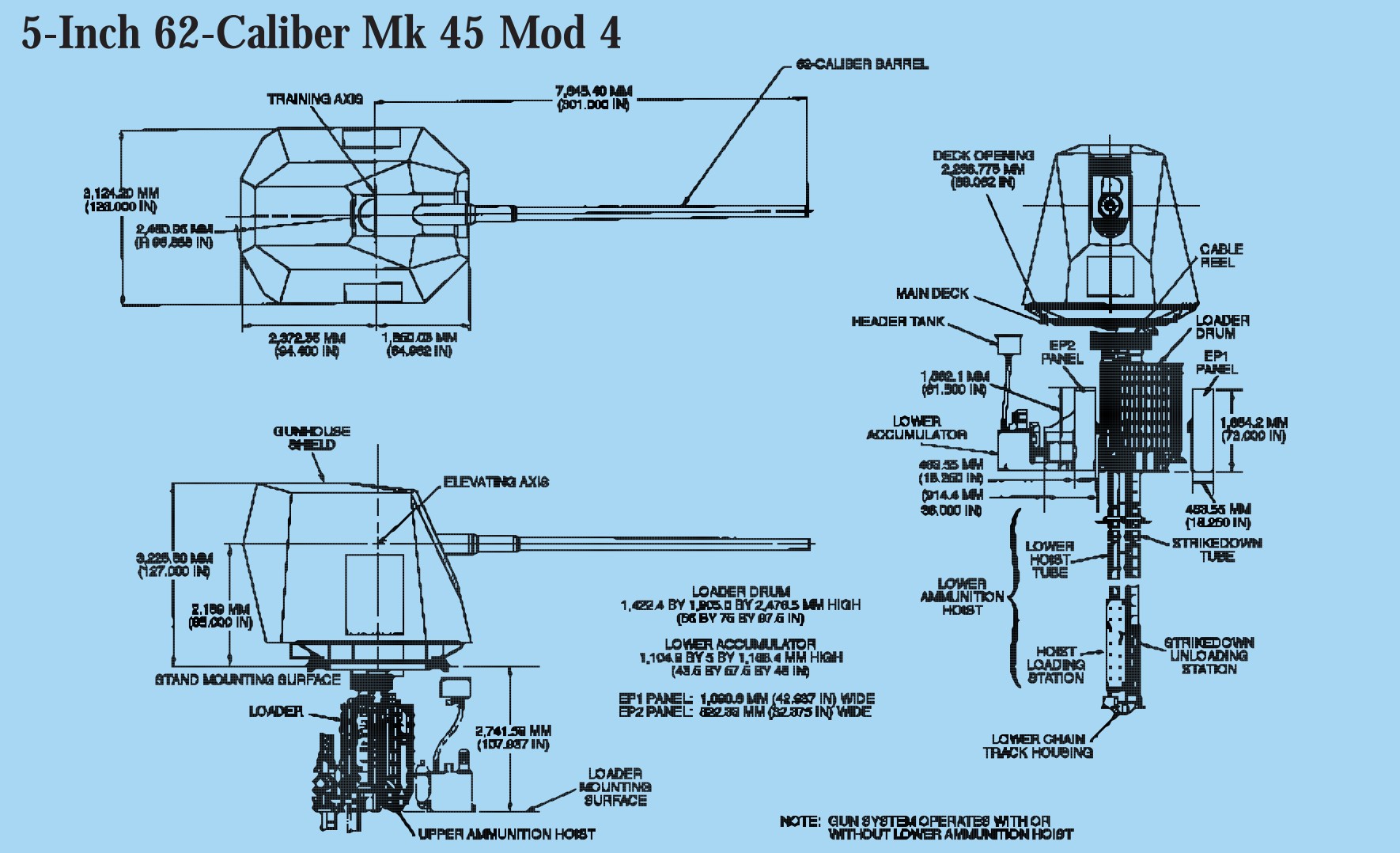
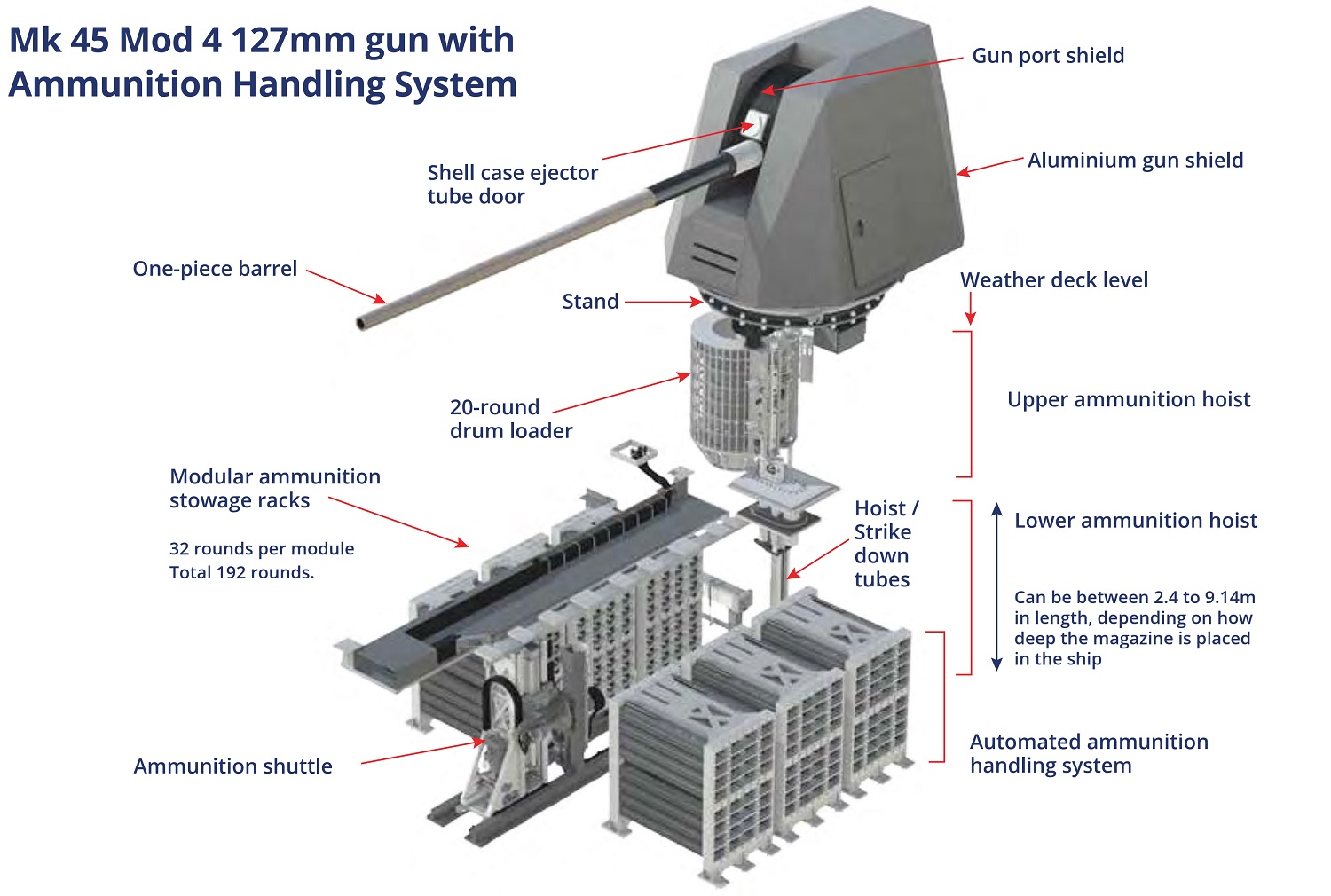
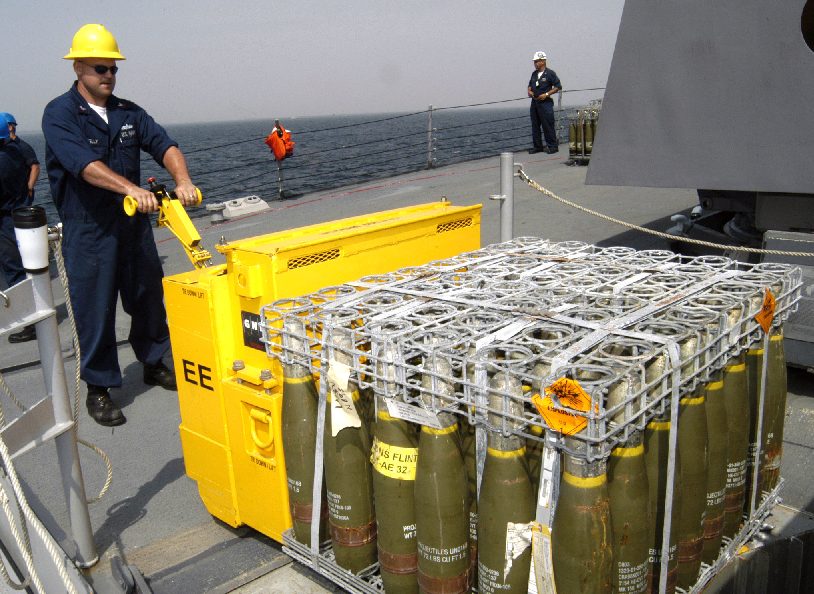
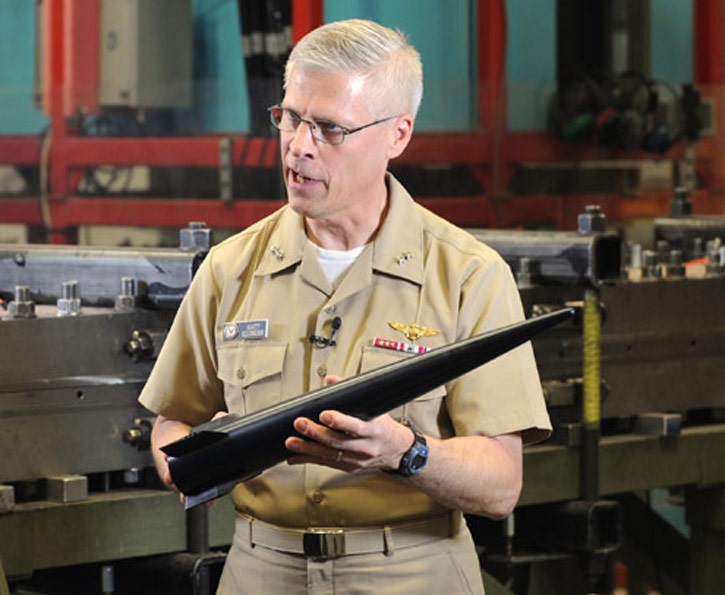
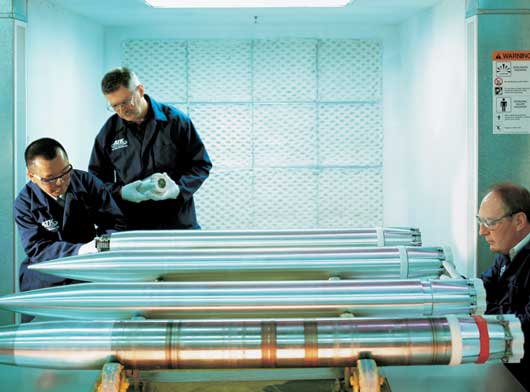
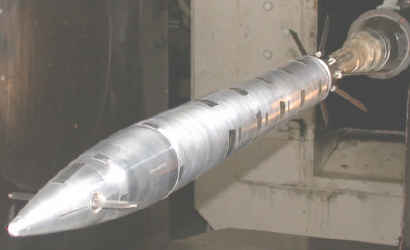

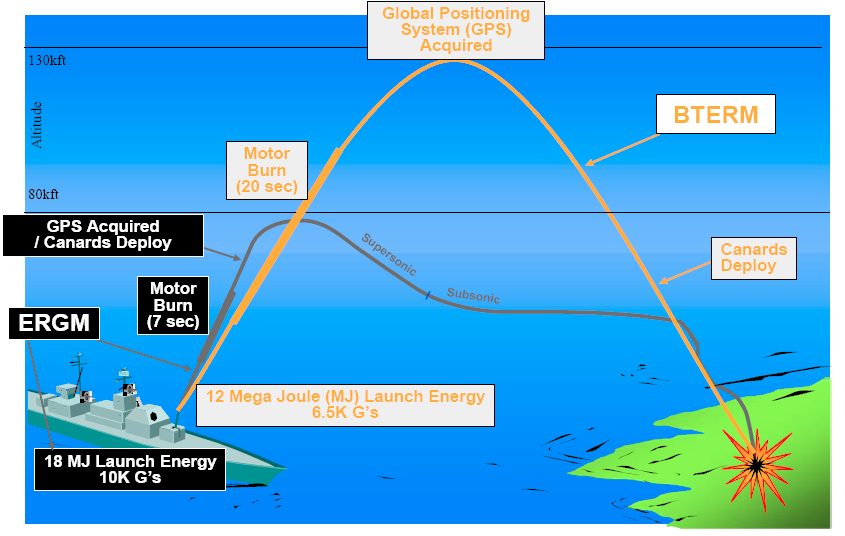
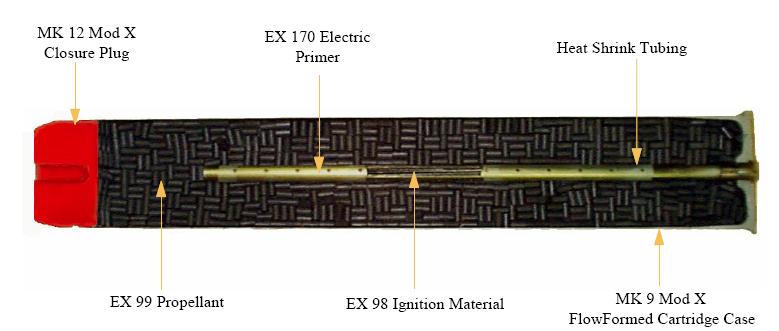
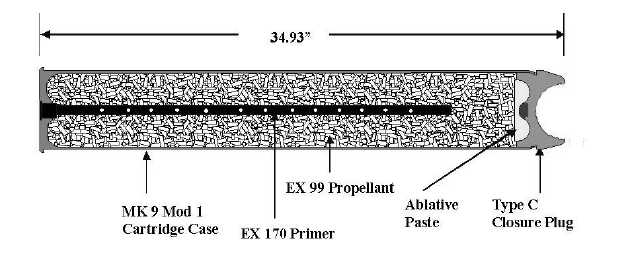
"The US Navy's Mk 45 Gun" article by Antony Preston in "Warship - Volume VII"
---
NAVSEA 5-inch Gun Ammunition Fact Sheets
---
DOD Office of the Inspector General Report
D-2005-078
"Audit of the Extended Range Guided Munition Program"
GAO Report GAO-04-248
"Defense Acquisitions:Assessments of Major Weapon Programs"
GAO Report GAO-05-39R
"Information on Options for Naval Surface Fire Support"
GAO Report GAO-11-233SP
"Defense Acquisitions:Assessments of Selected Weapon Programs"
House Armed Services Committee Subcommittee
on Projection Forces report FY
2006 Navy Critical Systems Capabilities Program, March 15, 2005
---
"5 Inch Cargo ICM Extended Range Projectile
Program" by Carol A. Watkins, Naval Surface Warfare Center, Dahlgren, presented
at the NDIA 36th
Annual Gun & Ammunition Symposium & Exhibition
"Naval Surface Fire Support Overview"
by Major Jeff Graham, USMC, presented at the NDIA
June 2004 International Armaments Technology
Symposium & Exhibition
"Navy-DDG 1000/ Long Range Land Attack
Projectile & DDG Extended Range Munition" by Commander Kevin LaPointe,
USN, presented at NDIA
Precision Strike Annual Programs Review, 24-25 April 2007
"Evaluation of the Generalized Explicit
Guidance Law applied to the Ballistic Trajectory Extended Range Munition"
by Kishore B. Pamadi, Naval Surface Warfare Center, Dahlgren Laboratory,
presented at the NDIA
41st Annual Armament Systems: Guns and Missile Systems Conference &
Exhibition
"Inductive Interface for ERGM GPS Guided Projectile - Background and Test Results" by George Wiles, presented at
the NDIA 41st Annual
Armament Systems: Guns and Missile Systems Conference & Exhibition
"Visionary Concepts & Operational
Realities:Putting a Longer Reach Into Sea Power 21" by Daniel Goure,
web-published in February 2003 at Navy
League of the United States
---
"Concept of Operations for Surface Combat Land Attack Warfare, 2005-2015" by Department of the Navy, 2003
Defense Daily, Vol. 228, No. 21
BAE Systems Awarded $245 Million Contract for UK Type 26 Gun System BAE Press Release dated 28 July 2016
---
"Closed
Loop Energetics with VOC Emission Reduction (CLEVER)" by Ashley Johnson,
Environmental Security Technology Certification Program (ESTCP), Department
of Defense, June 2003
---
"Navy ends ERGM funding" article by William Matthews in
Navy Times of 25 March 2008
"Pentagon No. 2: How to Keep Third Offset Going in the Next Administration" by Aaron Mehta in Defense News, 5 May 2016
"Navy Quietly Fires 20 Hyper Velocity Projectiles Through Destroyer's Deckgun" article by Sam LaGrone on
USNI website web-published in January 2019
"It May Be the End of the Line for the Navy's Hypervelocity Projectile" article by Hope Hodge Seck on
Military.com website web-published in June 2021
"Navy Lasers, Railgun, and Hypervelocity Projectile: Background and Issues for Congress" by Ronald O'Rourke on
Naval History and Heritage Command website
"Army to sole-source deal for hypervelocity projectiles, drone-killing artillery cannon" article in DefenseScoop by Jon Harper
---
Alliant Techsystems Press Releases
BAE Press Releases
Naval Surface Warfare Center Press Releases and Presented Papers
Raytheon Systems Company Press Releases
US Navy Press Releases
---
Special help from Leo Fischer
7 April 2008 - Benchmark
18 April 2010 - Added information about use on Japanese, Korean and Danish ships
26 September 2011 - Added gun barrel designation, end of ERM program
10 June 2016 - Converted to HTML 5 format
28 July 2016 - Added BAE winning contract for Type 26 Frigates
15 September 2018 - Reorganized notes
20 December 2019 - Added use on Ticonderoga Flight II Cruisers
14 April 2020 - Added mounting sketch
09 September 2020 - Added HVP section and photographs
03 October 2020 - Minor changes for clarity
29 December 2020 - Corrected typographical errors
04 July 2021 - Noted the end of the HVP program
09 December 2021 - Corrected typographical error, updated to latest template
10 February 2022 - Removed broken link
21 December 2022 - Added BAE mounting diagram
30 March 2025 - Updated HVP program status

